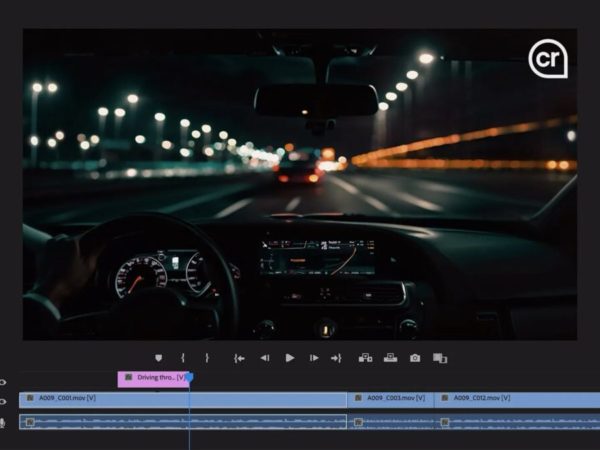Description automatically generated" data-ezsrc="https://computingforgeeks.com/ezoimgfmt/lh3.googleusercontent.com/TUbYRTUpdeH0mj_pFhF2ZBi5NgCJLnV4hw0s7gTeepCn3Ot3qf2bUtk5ViZIKM8VTKln1qg30aFPwO1Pi-mn8eD_VBKtADpwGVsowBavT0Uv2pUd9elzYnKA-1MAsuat1Bvim74DXCO-zA7gRw" ezimgfmt="rs rscb8 src ng ngcb8" src="data:image/svg xml,”>
HTML5 has become the new standard as the face of the web. When we are talking about client-side functionality (via the browser); plugins are on the way out. HTML5 is becoming the de facto language of not only static websites but web apps too – and even mobile apps. But is this technology safe? By using HTML5 websites or building them yourself, does it make you or the visitor more at risk? Today we take a deeper look at the safety of HTML5 on the web.
What is HTML5?
HTML5 is the latest version of HTML – the language that all websites display in the browser. If you see something in the browser, it’s all HTML – even if it’s a wrapper for another technology such as CSS (Cascading Style Sheets).
HTML is a standard that has been developed by some of the world’s top engineers in collaboration with internet authority bodies, industry experts, and those on the cutting edge of technology. Because it’s a supported worldwide standard, it’s come to be the leading technology across browsers.
This version of HTML was released in 2014, and follows HTML4, released in 1997. As you can imagine, a lot changed in the way the internet works from 1997 to 2014! The latest HTML5 update is the HTML 5.2 recommendation, published by the World Wide Web Consortium (W3C) in 2017.
HTML 5 is currently used by 82.2% of all websites, according to W3Techs.
So, is HTML5 safer than the previous version/s of HTML?
Yes, HTML5 is safer by design than it’s predecessors, despite the increase in features and functionality.
Did HTML5 kill Flash?
Yes! But that’s a good thing. Adobe Flash is a now-deprecated plugin that allowed browsers to play multimedia and interactive content. However, Flash was often criticized for its security flaws. The way that the technology worked meant that it was possible to have malicious scripts execute within the plugin, then accessing the rest of the resources on the computer.
While HTML5 doesn’t have the entire range of faculties that Flash did, it is inherently more secure, due to the sandboxed environment.
What about JavaScript?
JavaScript is still here to stay! While there was a hubbub years ago about Flash vs JavaScript, the decision for HTML5 to support JavaScript really sounded Flash’s death knell. JavaScript allows you to do things like add multimedia elements and dynamic content all with HTML5. Because of the way that JavaScript works, within the browser, and without access to elements such as memory or the CPU, this means that it is fairly safe – as long as it is set up correctly.
Are there any safety issues?
As with any programming language, HTML5 is only as safe as the practices of the developer who creates with it. However, HTML5 is seen as much more robust in terms of safety because of this sandboxing. You are more at risk of unsafe or unstable behavior when combining with JavaScript, although, again, an experienced developer will be able to successfully implement both without concerns – especially after thorough testing. It is malicious developers who are the real worry help.
What type of sites are made with HTML5?
There are so many different categories of sites that can be created with HTML5. Often HTML5 is used in combination with various frameworks, such as Ionic (which is perfect for building mobile apps).
What can you build? We are talking anything from productivity web apps, to online casino and slots houses which you can see featured here that are available both on the web and via mobile browsers, to simple one-page homepages for small businesses.
How about the back-end technologies?
Client side (the browser) and server side (the back end) only communicate via an agreed upon set of rules. What you do on the server side is a completely different story from the client side, and each language comes with its own complexities. A common server combination is Ruby on Rails. This being said, the best language to choose for server side for security is always the one that the developer knows best!
How do we stay safe and secure?
The way to stay up to date is to patch whenever the latest security updates come out. If a language update contains new security features, then update old code to the latest version and include them. Encourage people to update their browser often. Be open and aware of changes. It may be a little frustrating to remain up to date, however it keeps everyone safe in the long run.
it’s safe?
Yes, go forth and HTML5. Stay away from creepy unverified sites that give you malware warnings. Update your security protection. Build secure websites and web apps (by learning how to code safely!). And most importantly, have fun.



